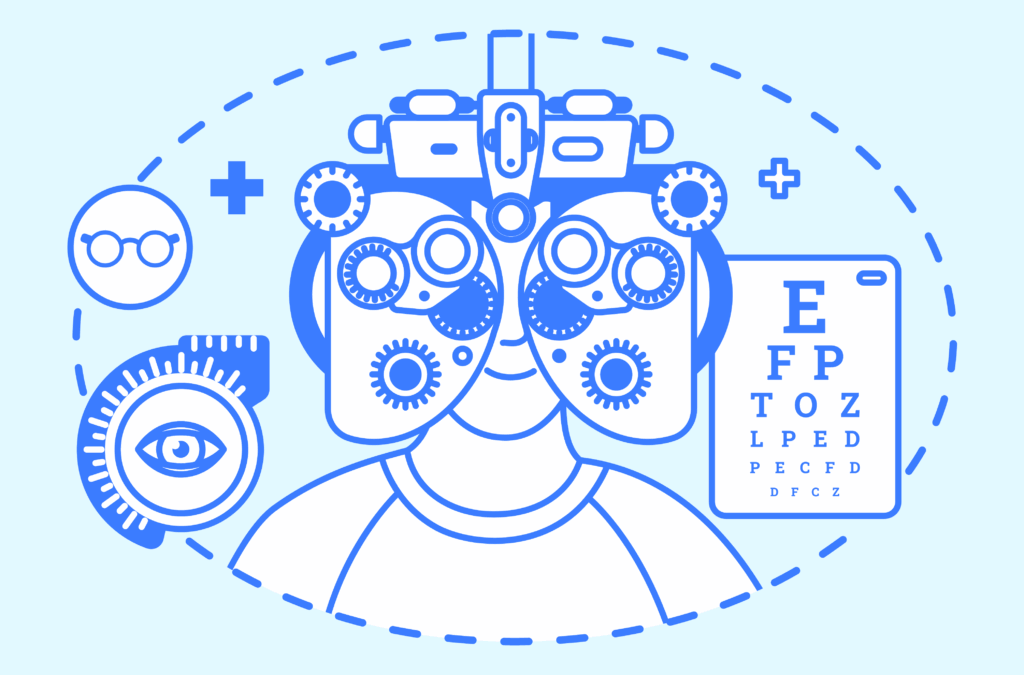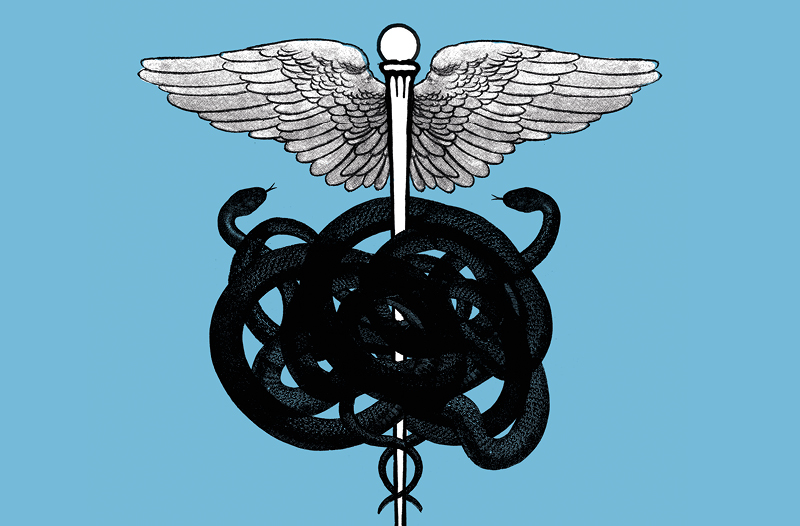
Ungodly Errors

Generations of medical students have been advised that when they hear hoof beats, they should think of horses, not zebras.
But sometimes the correct diagnosis really is a zebra—or at least a different breed of horse than what the doctors think they’re seeing. An estimated 15% to 26% of medical cases are misdiagnosed annually, according to various studies published in the past few years by the American Journal of Medicine, the Mayo Clinic Proceedings and others.
The errors can be minor, with no serious harm to the patient or effect on the outcome of treatment. But sometimes the mistakes are critical and lasting—missed signs of a stroke in the emergency room or a doctor who diagnoses and treats for the wrong type of cancer.
A 2009 Johns Hopkins study estimated misdiagnoses are responsible for 40,000 to 80,000 hospital deaths a year. A study by medical researchers in Texas, published this spring in the British journal BMJ Quality and Safety, estimates 12 million U.S. adults are misdiagnosed at a doctor’s office or outpatient facility each year.
These studies and others indicate diagnostic errors deserve as much attention as well-publicized problems with bungled prescriptions and with major infections acquired during hospital stays. By one measure, misdiagnoses are starting to get that attention: lawsuits for diagnostic errors are twice as high as those for medication errors.
A recent study published in the Journal for Healthcare Quality found diagnostic errors accounted for 8% of all catastrophic payouts—awards of $1 million or more—in malpractice cases. Misdiagnoses have twice the odds for a catastrophic payout and are also the top cause of malpractice awards under $1 million, say researchers at Johns Hopkins.
“These findings … suggest that health systems’ quality improvement initiatives should focus attention on ensuring diagnostic accuracy, perhaps with the assistance of computer-aided diagnosis or decision-support technologies,” the authors wrote.
An estimated one third of the $2.9 trillion spent on healthcare annually in the United States is squandered, according to various studies, and medical errors are believed to be a significant part of that drain on resources.
In 2009, the Institute of Medicine calculated the cost of preventable medical errors at hospitals—including lost productivity and income, disability and the need for additional medical care—was between $17 billion and $29 billion. The institute is working on a comprehensive report, scheduled for release next year, that’s expected to help define how large a problem misdiagnoses are today, how much they’re affecting the economy and how they can best be addressed.
In the meantime, some employers and insurers are exploring ways—tentatively in most cases, it appears—to reduce the damage caused by diagnostic errors and generally improve the quality and cost-efficiency of healthcare provided through benefits plans.
Wellness Works
Wellness programs that stress yearly checkups, routine screenings and healthier lifestyle choices are the most basic approach. Among the medical tips offered to employees: They should be sure to provide full personal and family medical histories to their doctors and ask plenty of questions during visits to reduce the chances that a major problem will be overlooked.
By most measures, wellness programs work. A 2010 study by Harvard researchers found medical costs fall by about $3.27 for every dollar spent on wellness efforts. The savings in absenteeism was about $2.73 per dollar spent, they reported in the journal Health Affairs.
But some employers, including Fortune 500 firms, are venturing beyond wellness programs and offering benefits packages that included varying levels of so-called concierge services to help workers navigate the complexities of their healthcare.
The general goal is cost-containment and quality assurance. Services range from reviewing medical bills to spot errors that threaten an employee’s bank account to double-checking diagnoses for errors could that threaten the employee’s life.
The rate of diagnostic errors has remained fairly steady over the years. As the nation wrestles with rising healthcare costs and the implementation of the Affordable Care Act, policymakers and benefit providers suspect there are significant savings to be found in a more aggressive attempt to reduce mistakes.
God Talking
Michael Turpin, a former regional CEO for UnitedHealthcare who is now executive vice president for benefits at USI Insurance Services, says there are probably a multitude of reasons for the persistent rate of diagnostic errors, including patients’ “deification” of the medical profession—a belief that if their doctor says it’s so, it must be.
Turpin says the medical profession too often uses HIPAA privacy protections as a shield against inquiries into what went wrong in a misdiagnosis. Doctors protect each other with a “foam green line of silence,” he says.
Part of the failure to reduce diagnostic errors over the years, Turpin and others say, may be traced to a decline in people asking for second opinions. Turpin says second opinions became less common after a patient rebellion against “mother-may-I medicine,” when insurance companies recommended or required a second opinion before approving procedures.
Over time, patients began to distrust the value of second opinions and view them as an attempt by insurers and employers to deny coverage. And some employers began to see it as a frivolous benefit, Turpin says.
The tide could be turning with innovations from companies that offer a variety of concierge services. Turpin points to the growth in companies such as Best Doctors, Compass, Private Health, Health Advocate and Quantum Health, among others.
Best Doctors is a Boston-based network of 53,000 physicians with 30 million clients worldwide. Among the services it offers: a review of diagnoses and pathology reports on serious illnesses.
Evan Falchuk, a co-founder of the company, noted in an op-ed column in the Seattle Times that the horses-not-zebras “cognitive shortcut” generally works well. But, Falchuk wrote, “combined with the pressured reality of modern medical practice, it impacts a doctor’s capacity for critical thinking.”
“In today’s system,” Falchuk wrote, “doctors easily see a hundred or more patients a week and often spend scant minutes with each—nowhere near the time needed to examine all medical possibilities and important related factors like a patient’s full family medical history.”
Best Doctors offers to step in to fill the gap. Justin Joseph, a company spokesman, says members of the team, deemed among the best in their field, are called upon to review tens of thousands of cases annually.
According to Best Doctors, the company refined or corrected diagnoses in 37% of cases reviewed in the United States last year.
Those catches save money and curb lost productivity. Most importantly, Joseph says, they save employees from unneeded suffering or worse. He says the financial savings to employers depend on the benefits package design and process for referral, but the return “can range from break even to over 3-to-1.”
Best Doctors and similar services that help patients navigate their healthcare are growing, but the response from employers seems to be mixed.
LeAnn Tobin, senior vice president and director of the employees benefits division at RCM&D, says her company hasn’t had any clients reach out for use of a vendor to provide second opinions or raise concerns about the effect of misdiagnoses on healthcare costs. Other brokers offer a similar take.
But Anita Verheul, executive vice president in the employees benefits division at William Gallagher Associates, sees a potential for growth in firms that offer second opinion services as well as those offering broader help to people working their way through the often-fragmented healthcare system.
WGA has several clients that include Best Doctors in their employee benefits package, Verheul says, and the response has been favorable. “I think the clients who have had it love it,” she says.
The feedback, she says, is similar for CoPatient, a firm that helps patients decipher—and find errors—in increasingly complex medical bills. Other companies offer reviews of bills and medical records.
Quantum Health, for example, uses care coordinators to provide 340,000 plan participants at roughly 80 employers with real-time guidance on navigating their healthcare choices. The company says it saves benefits providers 7% to 8% annually.
Turpin says one obstacle to second opinion and similar services is the fear among employees that the programs are Trojan horses used by employers and insurers to deny care.
But it’s all in the messaging, Verheul says, and one testimonial from an employee whose misdiagnosis was caught by Best Doctors or a similar service can ease those fears.
“All it takes is for one employee to step forward” with a success story, she says, and other employees—and employers—begin to see the benefits.
Dr. Eric Bricker, the chief medical officer and a co-founder of Compass Professional Health Services, has seen his company grow to 1,800 clients with 2 million patients nationwide since its start-up in 2007. Compass essentially serves as a patient advocate, providing comparative data on quality and costs of physicians and services and helping patients better understand their care options. The company also acts as a liaison between physicians, retrieves medical records and helps patients review their bills. According to Compass, its services provide an average 8-to-1 return on investment.
Bricker has a distinct perspective on healthcare. He started work in hospital finance in 1998 handling medical claims, then received medical training at the University of Illinois College of Medicine and Johns Hopkins Hospital.
When he was working in hospital finance in the 1990s, he says, patients would occasionally ask in advance about the cost of a particular procedure. Staff members often had no idea where to find a price to quote, he says.
Bricker says one of the contributors to misdiagnoses is a professional mystique that leads clients to invest enormous trust in their doctors. “In general, people actually like their doctors,” he says. “It’s amazing how forgiving people are, even for a misdiagnosis.”
Bricker says diagnostic errors generally fall into two categories: errors of commission—say, a doctor dismisses early signs of cancer as a sore throat—and errors of omission. The latter are the most insidious, he says.
“One of the biggest errors of omission is just people not getting their preventive screening, such as breast cancer, colonoscopy, cardiovascular screening,” he says. “It’s people not being compliant—and their physicians not being compliant for that matter.”
Bricker says physicians probably see those omissions in their clinic or their hospital “if not on a daily basis, certainly on a weekly basis.”
The push for basic wellness care can make a dramatic difference. “We see people being more proactive about their care. We’ve actually helped catch leukemia earlier,” he says.
As part of its services, Compass helps patients find second opinions. Bricker estimates that one third of its work involves helping patients choose physicians, and about 10% of those involve patients seeking a review of what they’ve been told by other doctors.
Sometimes the help is simply a matter of pairing a patient with the right doctor, Bricker says. An employee with multiple sclerosis in rural Texas, for example, might have trouble finding a neurologist she’s comfortable with. Compass assists with lining up a doctor who might confirm another doctor’s advice or suggest a more aggressive therapy, he says.
Turpin, who’s worked 30 years as a benefits executive, broker and consultant, says these programs are injecting a much-needed level of consumerism into the healthcare industry. Insurers have “utterly failed” to serve as sentinels or ombudsmen for healthcare consumers, he says.
If the answer to filling the void lies with concierge services, it will have to be from companies that consumers themselves choose as trusted brands, Turpin says. “It will never be an insurer or an employer.”
Bricker agrees the impartiality of services like Compass help build trust. “I think it helps that we’re a third party. It helps that we’re not the insurance company or the employer.”
Turpin suspects Best Doctors and other services will grow in popularity among younger people more deeply immersed in a digital world than their parents and grandparents. “The generation coming after us will be more comfortable with Skype and telemedicine,” he says.
In its report on medical errors 15 years ago, researchers for the Institute of Medicine noted, “It may be part of human nature to err, but it is also part of human nature to create solutions, find better alternatives, and meet the challenges ahead.”
Next year’s report by the institute might shed some light on those solutions. Meanwhile, private industry is already generating approaches intended to better separate the zebras from the horses.




